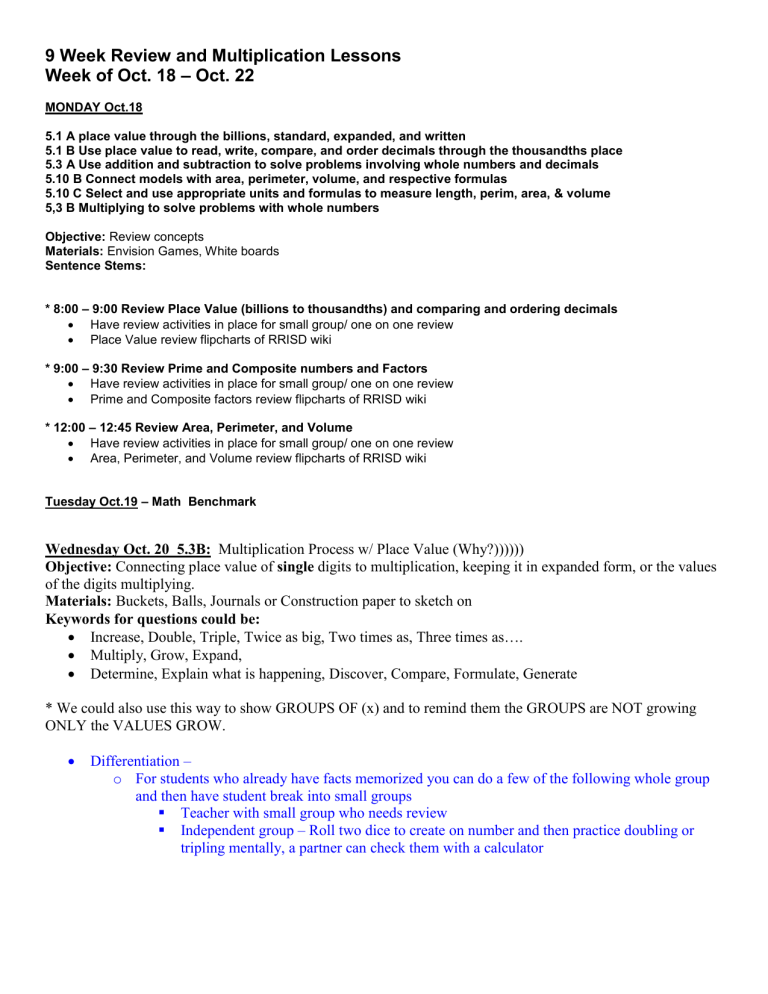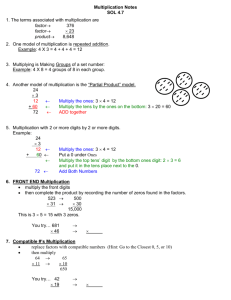1st Nine Week Review and Multiplication LP 10

9 Week Review and Multiplication Lessons
Week of Oct. 18 – Oct. 22
MONDAY Oct.18
5.1 A place value through the billions, standard, expanded, and written
5.1 B Use place value to read, write, compare, and order decimals through the thousandths place
5.3 A Use addition and subtraction to solve problems involving whole numbers and decimals
5.10 B Connect models with area, perimeter, volume, and respective formulas
5.10 C Select and use appropriate units and formulas to measure length, perim, area, & volume
5,3 B Multiplying to solve problems with whole numbers
Objective: Review concepts
Materials: Envision Games, White boards
Sentence Stems:
* 8:00 – 9:00 Review Place Value (billions to thousandths) and comparing and ordering decimals
Have review activities in place for small group/ one on one review
Place Value review flipcharts of RRISD wiki
* 9:00 – 9:30 Review Prime and Composite numbers and Factors
Have review activities in place for small group/ one on one review
Prime and Composite factors review flipcharts of RRISD wiki
* 12:00 – 12:45 Review Area, Perimeter, and Volume
Have review activities in place for small group/ one on one review
Area, Perimeter, and Volume review flipcharts of RRISD wiki
Tuesday Oct.19 – Math Benchmark
Wednesday Oct. 20 5.3B: Multiplication Process w/ Place Value (Why?))))))
Objective: Connecting place value of single digits to multiplication, keeping it in expanded form, or the values of the digits multiplying.
Materials: Buckets, Balls, Journals or Construction paper to sketch on
Keywords for questions could be:
Increase, Double, Triple, Twice as big, Two times as, Three times as….
Multiply, Grow, Expand,
Determine, Explain what is happening, Discover, Compare, Formulate, Generate
* We could also use this way to show GROUPS OF (x) and to remind them the GROUPS are NOT growing
ONLY the VALUES GROW.
Differentiation – o For students who already have facts memorized you can do a few of the following whole group and then have student break into small groups
Teacher with small group who needs review
Independent group – Roll two dice to create on number and then practice doubling or tripling mentally, a partner can check them with a calculator
Beginning with the ONES bucket, have students throw a ball in the bucket. o Review what value is and how we determine the value of a digit (b/c of place value) o Have students sketch out: the bucket, with the one ball, and write the value of the one ball. Then ask students: “What would we do if we wanted this value to double?”
Students should draw a picture next to the bucket of another one ball, with the value inside, to allow students to actually SEE multiplication. o Move on from one ball to three or four in the ones place, ask again “How could we get this value to grow three times (or four times, or five times…..) from its original value?” o Again have students sketch it out, show the multiplication, and write the answer.
Then, move from the ones bucket to the TENS bucket and do the same thing. o Begin with one ball, sketch the bucket and ball, write the value of the ball. o Ask
“What if this value increased to twice its value?”
Work with that digit for a few different ways sketching o Again, move on from one ball to a couple of them, and keep asking them to multiply
Move on to the HUNDREDS doing the same steps
Focus have students see the value of the digits multiplying, keep it in expanded form, single digits.
HUNDREDS
100
An Example:
Just to give an idea
100
100
100
Monday Math Dog Time: FACTS Practice
Focus: Doubling, Tripling, Looking for patterns
100
100
100
100
100
900
Materials: Journals, or index cards, markers, pencils
Give students an index card, or a piece of construction paper folded into fourths, have students write 2 x
2, then have them draw that with dots
Next ask students,
“ If we DOUBLED 2 what number would we get?” o Then on another card, or in another column, have students write at the top 4 x 2 and ask them
“How could you use your first drawing to help you produce this answer?” o We’ll ask students to
Compare this product to your first. Discuss your comparisons with a partner.
Next ask students, “If we DOUBLED 4 what number would we get?” o Then, on another card, or in the next column, have students write at the top 8 x 2 and ask them,
“How could you use your other illustrations to help you produce this answer?” o We’ll ask students to Compare this product to your first two. Discuss your comparisons with a partner.
Next ask students,
“If we DOUBLED 8 what number would we get?” o Then, on another card, or in the next column, have students write at the top 16 x 2 and ask them,
“How could you use your other illustrations to help you produce this answer?” o We’ll ask students to
Compare this product to your first three. Discuss your comparisons with a partner.
2 x2 4 x2 8 x2 16 x2
**
**
**
**
**
**
** ** ** **
** ** ** **
** ** ** **
** ** ** **
** ** ** **
** ** ** **
As a class have students discuss the patterns they found
Have them develop ways to use this as a memorization technique.
Thursday Oct. 20 5.3B: Work with basic word problems to show TRADITIONAL ALGORITHM
Focus: Connecting traditional algorithm with place value and value
Materials: Word Problems, Promethean, rulers, paper and pencils, maybe graph paper
Use a basic word problem and have students determine if it is multiplication or division and justify their reasons. o Use the word problem to decide which is the value that will change and what are the groups that will stay the same. o Set the numbers up in the algorithm one number at a time. o Remind students the importance of keeping the place values in line
You may want a few students to set it up using graph paper (automatic lines) : )
Have students take a ruler, and draw vertical lines, to separate the ONES, TENS,
HUNDREDS, THOUSANDS o Students double check place values are in one line.
Explain to students that first we are going to find our ONES, like we did on Monday and Tuesday, we have to multiply EACH DIGIT, to find the new value of those digits.
This algorithm just helps us write the values in a short cut.
After we find how many ONES we move down to the next level to find how many TENS. o Since we just found the ones are we going to have any ones on this level? No, this is why we put a zero in the ONES place value because we are now multiplying by TENS.
Now that we found the ones and the tens, “How do we have to bring those values together?”
Adding them.
Try again with a couple more basic word problems.
Math Dog Time: Dog Time – Alternative Multiplication processes
Objective: Partial Product Math or Broken Window
Put students into groups of two or three o Give each group a set of base ten blocks
Roll a dice and remind students place value is important because it tells us the value, how much of that digit .
o After you roll the dice, tell the students which place value it will belong in, and then they build it, sketch it.
Ex: Roll a 4, “Let’s put this 4 in the TENS place”, then students should build the value of
40, and sketch it. o Connect w/ Mondays activity,
“What if I wanted this value to grow twice as big. Show me the value you would have. Be able to explain how you figured that out.” o Remind students they are multiplying these numbers and that multiplication is when values are getting bigger , but the groups stay the same.
Roll the die again, put the digit in a place value, have them build, have them show how it would multiply
Then take it two digits, Ex. 53, put them in the place value, and have students show EACH
INDIVIDUAL value 50 and 3 o Ask them
“What if we needed a value three times this value? How could we make that happen?” o Bring it back from expanded to standard, showing standard is a shorter way, a simpler way, to write that same value,
“If the number we have is 53? And we know 3 groups of 50 is 150 and
3 groups of 3 is nine? How could we bring those values back together?” o Have students build and show.
Roll two dice again, create a new number, ask them to build it and have then multiply that amount. o EX. 104, they build it and then ask them to increase the size four times, they should be able to show four groups of 104 and see the value of 400, 10, 6.
29 th Thursday 5.3B: Word Problems and Basic Algorithm
Focus: Continue to practice the basic algorithm using word problems
Materials: Word Problems, Promethean, rulers, paper and pencils, maybe graph paper
Use a basic word problem and have students determine if it is multiplication or division and justify their reasons. o Use the word problem to decide which is the value that will change and what are the groups that will stay the same. o Set the numbers up in the algorithm one number at a time. o Remind students the importance of keeping the place values in line
Let students try a couple on their own.
ASSESSMENT
We can use this assessment to see who to show variety of ways.
Friday Oct. 22 5.3B: Multiplication Extension
Focus: Reteach, show a variety of ways
Materials: Halloween Integration Word Problems
Halloween math integration with multiplication
Reteach can show variety of ways to multiply o Broken Window, Lattice, Partial Product
Multiplication game







